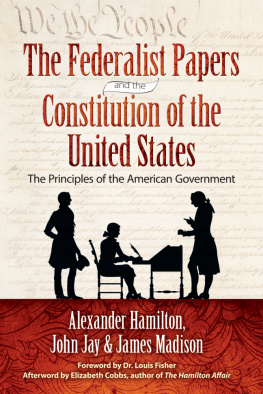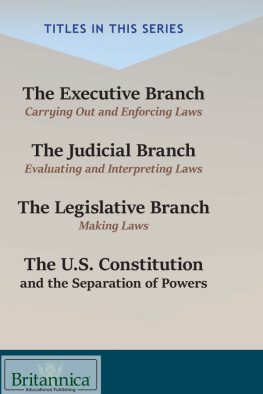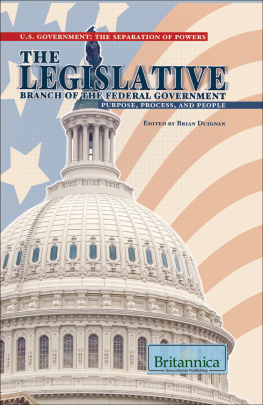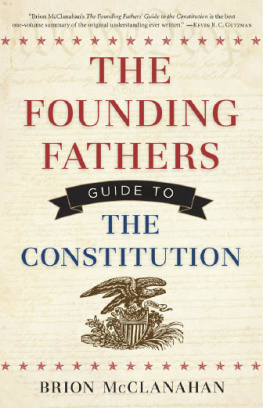THE LEGISLATIVE
BRANCH OF THE FEDERAL GOVERNMENT
PURPOSE, PROCESS, AND PEOPLE
U.S. GOVERNMENT: THE SEPARATION OF POWERS
THE LEGISLATIVE
BRANCH OF THE FEDERAL GOVERNMENT
PURPOSE, PROCESS, AND PEOPLE
EDITED BY BRIAN DUIGNAN, SENIOR EDITOR, RELIGION AND PHILOSOPHY

Published in 2010 by Britannica Educational Publishing
(a trademark of Encyclopdia Britannica, Inc.)
in association with Rosen Educational Services, LLC
29 East 21st Street, New York, NY 10010.
Copyright 2010 Encyclopdia Britannica, Inc. Britannica, Encyclopdia Britannica,
and the Thistle logo are registered trademarks of Encyclopdia Britannica, Inc. All
rights reserved.
Rosen Educational Services materials copyright 2010 Rosen Educational Services, LLC.
All rights reserved.
Distributed exclusively by Rosen Educational Services.
For a listing of additional Britannica Educational Publishing titles, call toll free (800) 237-9932.
First Edition
Britannica Educational Publishing
Michael I. Levy: Executive Editor
Marilyn L. Barton: Senior Coordinator, Production Control
Steven Bosco: Director, Editorial Technologies
Lisa S. Braucher: Senior Producer and Data Editor
Yvette Charboneau: Senior Copy Editor
Kathy Nakamura: Manager, Media Acquisition
Brian Duignan: Senior Editor, Religion and Philosophy
Rosen Educational Services
Hope Lourie Killcoyne: Senior Editor and Project Manager
Nelson S: Art Director
Matthew Cauli: Designer
Introduction by Richard Worth
Library of Congress Cataloging-in-Publication Data
The legislative branch of the federal government: purpose, process, and people / edited by Brian Duignan.
p. cm.(U.S. government: the separation of powers)
In association with Britannica Educational Publishing, Rosen Educational Services.
ISBN 978-1-61530-067-9 (eBook)
1. United States. Congress. 2. Legislative powerUnited States. 3. LegislatorsUnited
StatesHistory. 4. LegislatorsUnited StatesBiography. I. Duignan, Brian.
K1021.L45 2010
328.73dc22
2009037871
Cover credit: www.istockphoto.com/Dra Schwartz.
Photo credit: p. (The United States Capitol at night) www.istockphoto.com/Cheng Chang.
CONTENTS







Introduction

A s Americans were fighting for their independence during the Revolutionary War, they were governed under a framework known as the Articles of Confederation. The central government consisted of a Congress with representatives from each of the thirteen states. But the authority of the Congress was restricted, with most of the power resting with the states themselves. After independence from Great Britain had been secured by the Peace of Paris in 1783, many Americans realized that the Articles of Confederation were inadequate to govern the new nation. A new federal form of government eventually was established by representatives of the states who convened at a Constitutional Convention in Philadelphia in 1787.
Under the Constitution of 1787 there are three branches of government: the legislature, the executive, and the judiciary. The powers of the federal government are divided among the three brancheswith each one acting as a check and balance on the others. This prevents any single branchsuch as the executive or the legislaturefrom becoming too powerful. Given their colonial experience, Americans were wary of concentrating too much power in a single person or institution.
The authority of Congress is carefully spelled out in Article I of the Constitution. Among the primary powers of Congress is the exclusive authority to approve all legislation. This acts as a powerful check on the power of the president.
The framers of the Constitution created a bicameral legislaturethat is, one with two houses. In the lower house, or House of Representatives, each state receives a specified number of representatives based on the size of its population. This apportionment ensures that the larger states, such as California and Texas, have more votes than the smaller states. This important provision was hammered out in the Constitutional Convention to ensure the support of the large states for the new framework of government. Each representative is elected directly by the people in a congressional district for a term of two years. The framers of the Constitution wanted frequent elections for House members so that they would be forced to pay close attention to the needs of the constituents in their districts or risk being turned out of office at election time. Currently there are 435 representatives from fifty states.
In contrast to the House of Representatives, the United States Senate has a smaller number of members and operates differently. Under the Constitution, each state has two senators; there are currently 100 senators. This allocation ensures that every state will have the same voice in the U.S. Senate. Delegates from the small states at the Constitutional Convention, such as New Jersey and Connecticut, wanted this measure so that they would not be overwhelmed by the larger states. Unlike representatives in the House, United States senators serve for a term of six years. The Founding Fathers believed that this would enable the Senate to become a more deliberative bodyone that was not swayed by the changing tide of public opinion because the members did not need to stand for reelection every two years.
Under Article I, Section 3 of the Constitution, senators were elected by the legislature in each state. This insulated them even further from the whims of the voters. However, the Seventeenth Amendment, passed in 1913, changed the way that senators were elected. Instead of being elected indirectlyby voters casting ballots for state legislators who in turn selected a states U.S. senatorsthey are elected directly by voters from an entire state. One-third of the U.S. Senate stands for reelection every two years.
During the 19th century, the Senate was dominated by stirring debates among men such as Henry Clay of Kentucky, Daniel Webster of Massachusetts, and John C. Calhoun of South Carolina, who delivered impassioned speeches about the future of states rights and slavery. In 1858 Democrat Stephen A. Douglas of Missouri defended his Senate seat in a series of debates over slavery with Republican Abraham Lincoln. These debates helped propel Lincoln to election as president in 1860. Later in the century, senators Robert La Follette of Wisconsin and William Borah of Idaho dominated the floor of the Senate with speeches about curbing the power of big business and rooting out corruption in government.
Next page




















